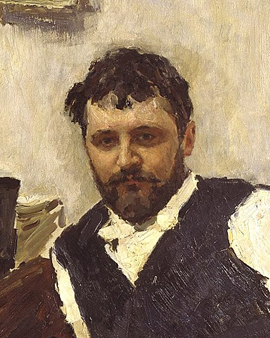Konstantin Alekseevich Korovin is one of the first Russian impressionists. The reception of his works was diverse. One of the few contemporaries who recognized the talent of the painter was Fedor Shalyapin. The singer called him the "Paganini in painting". At that time, few agreed with the opinion of Shalyapin. Konstantin Alekseevich Korovin was born into a wealthy merchant family. His eldest brother, Sergei Korovin, also studied painting. The 14-year-old Korovin initially decided to study architecture, but a year later transferred to the Faculty of Painting, which was headed by the landscape painter Aleksei Savrasov and Vasilij Polenov.
The artist Ilya Repin found much to like in his first painting from the early 1880s. He was clearly impressed with the coloring, boldness of technique and design and demanded to meet the creator of the work in person. Many art lovers assumed that a Spaniard had created the painting, as Russian artists preferred a different style. Korovin spent much time abroad, especially in France, though he was always drawn back to his homeland. Around 1920, for political reasons, the artist was deprived of his country house and apartment in the capital. Following the advice of Anatoly Lunacharsky, Korovin emigrated to Paris in 1923, justifying his departure with the need to treat his son's health. Life in Paris was difficult. Modernists, such as Korovin was, were out of fashion. The lack of money was growing steadily and his acquaintances and friends had remained in Russia. Konstantin Korovin longed for his homeland, for Abramtsevo and Okhotino. Adding to his misfortune was the loss of his eyesight. To stay busy, the artist seized his memories and discovered his talent for writing. He wrote short stories and memoirs.
Korovin's painterly goal was to transfer light and air to canvas. The painting "At the Tea Table" is a vivid demonstration of the accomplishment of this task. The composition of the canvas is based on the artistic orientation of Impressionism. Konstantin Alekseevich Korovin is also known as a talented creator of still lifes with flowers. He particularly often depicted lilacs and roses. Like all modernist works, Korovin's still lifes and landscapes are best viewed from a distant perspective.
×





.jpg)
.jpg)
.jpg)
.jpg)
.jpg)
.jpg)
.jpg)
.jpg)
.jpg)
.jpg)
 1911 - (MeisterDrucke-194462).jpg)
 1911 - (MeisterDrucke-194462).jpg)
_Oil_on_cardboard_Di_-_(MeisterDrucke-959828).jpg)
_Oil_on_cardboard_Di_-_(MeisterDrucke-959828).jpg)
.jpg)
.jpg)
_Nature_morte_avec_bouquet_assiette_de_frui_-_(MeisterDrucke-1322970).jpg)
_Nature_morte_avec_bouquet_assiette_de_frui_-_(MeisterDrucke-1322970).jpg)
_(Paris)_Vue_des_facades_du_boulevard_Montmartre_un_matin_dautomne_-_(MeisterDrucke-1318513).jpg)
_(Paris)_Vue_des_facades_du_boulevard_Montmartre_un_matin_dautomne_-_(MeisterDrucke-1318513).jpg)
_(Gurzuf)_Vue_du_riv_-_(MeisterDrucke-1321100).jpg)
_(Gurzuf)_Vue_du_riv_-_(MeisterDrucke-1321100).jpg)
_Vue_du_pont_qui_mene_a_la_ville_avec_les_facades_de_-_(MeisterDrucke-1318016).jpg)
_Vue_du_pont_qui_mene_a_la_ville_avec_les_facades_de_-_(MeisterDrucke-1318016).jpg)
.jpg)
.jpg)
.jpg)
.jpg)
.jpg)
.jpg)
.jpg)
.jpg)
.jpg)
.jpg)
.jpg)
.jpg)
_Vue_du_croisement_-_(MeisterDrucke-1313769).jpg)
_Vue_du_croisement_-_(MeisterDrucke-1313769).jpg)
.jpg)
.jpg)
.jpg)
.jpg)
_Une_table_dressee_dans_les_bosquets_lete_trois_je_-_(MeisterDrucke-1321022).jpg)
_Une_table_dressee_dans_les_bosquets_lete_trois_je_-_(MeisterDrucke-1321022).jpg)
.jpg)
.jpg)
.jpg)
.jpg)
.jpg)
.jpg)
.jpg)
.jpg)
_Femmes_attablees_pres_dune_baie_vitree_eclairee_de_lant_-_(MeisterDrucke-1313977).jpg)
_Femmes_attablees_pres_dune_baie_vitree_eclairee_de_lant_-_(MeisterDrucke-1313977).jpg)
.jpg)
.jpg)
_Une_belle_femme_melancolique_les_yeux_mi_clo_-_(MeisterDrucke-1320668).jpg)
_Une_belle_femme_melancolique_les_yeux_mi_clo_-_(MeisterDrucke-1320668).jpg)
_-_(MeisterDrucke-891167).jpg)
_-_(MeisterDrucke-891167).jpg)
.jpg)
.jpg)
.jpg)
.jpg)
.jpg)
.jpg)
.jpg)
.jpg)
.jpg)
.jpg)
.jpg)
.jpg)
.jpg)
.jpg)
_(Stage_Desi_-_(MeisterDrucke-1323267).jpg)
_(Stage_Desi_-_(MeisterDrucke-1323267).jpg)
.jpg)
.jpg)
.jpg)
.jpg)
_Vue_de_quais_de_la_Seine_avec_un_attelage_a_cheva_-_(MeisterDrucke-1320800).jpg)
_Vue_de_quais_de_la_Seine_avec_un_attelage_a_cheva_-_(MeisterDrucke-1320800).jpg)
_Description_de_lanimatio_-_(MeisterDrucke-1325585).jpg)
_Description_de_lanimatio_-_(MeisterDrucke-1325585).jpg)
 1913 - (MeisterDrucke-164003).jpg)
 1913 - (MeisterDrucke-164003).jpg)
.jpg)
.jpg)
 - (MeisterDrucke-179785).jpg)
 - (MeisterDrucke-179785).jpg)
.jpg)
.jpg)
.jpg)
.jpg)
_Peinture_de_Konstantin_Alexeyevich_Korovin_(Constantin_Korovine)_(_-_(MeisterDrucke-1325877).jpg)
_Peinture_de_Konstantin_Alexeyevich_Korovin_(Constantin_Korovine)_(_-_(MeisterDrucke-1325877).jpg)
.jpg)
.jpg)
.jpg)
.jpg)
_(18_-_(MeisterDrucke-994919).jpg)
_(18_-_(MeisterDrucke-994919).jpg)
_Illustration_pour_Eugene_Oneguine_roman_dAle_-_(MeisterDrucke-1320413).jpg)
_Illustration_pour_Eugene_Oneguine_roman_dAle_-_(MeisterDrucke-1320413).jpg)
.jpg)
.jpg)
_Portrait_dune_jeune_femme_gaie_-_(MeisterDrucke-1321001).jpg)
_Portrait_dune_jeune_femme_gaie_-_(MeisterDrucke-1321001).jpg)
_Minkus_(1826-19_-_(MeisterDrucke-1325073).jpg)
_Minkus_(1826-19_-_(MeisterDrucke-1325073).jpg)
_Description_du_boulevard_Montmartre_et_de_son_animation_un_-_(MeisterDrucke-1318662).jpg)
_Description_du_boulevard_Montmartre_et_de_son_animation_un_-_(MeisterDrucke-1318662).jpg)
.jpg)
.jpg)
.jpg)
.jpg)
_Vue_du_-_(MeisterDrucke-1318510).jpg)
_Vue_du_-_(MeisterDrucke-1318510).jpg)
.jpg)
.jpg)
.jpg)
.jpg)
.jpg)
.jpg)
.jpg)
.jpg)
.jpg)
.jpg)
.jpg)
.jpg)
_Sur_une_table_un_plat_re_-_(MeisterDrucke-1313408).jpg)
_Sur_une_table_un_plat_re_-_(MeisterDrucke-1313408).jpg)
.jpg)
.jpg)
_(Yakunchiko_-_(MeisterDrucke-1313645).jpg)
_(Yakunchiko_-_(MeisterDrucke-1313645).jpg)
.jpg)
.jpg)
.jpg)
.jpg)
.jpg)
.jpg)
_Minkus_(1826-19_-_(MeisterDrucke-1318626).jpg)
_Minkus_(1826-19_-_(MeisterDrucke-1318626).jpg)
_(Gurzuf)_Scene_de_rue_dans_le_village_portuaire_aux_maisons_de_-_(MeisterDrucke-1313993).jpg)
_(Gurzuf)_Scene_de_rue_dans_le_village_portuaire_aux_maisons_de_-_(MeisterDrucke-1313993).jpg)
.jpg)
.jpg)
.jpg)
.jpg)
_Vue_de_la_rue_dun_village_aux_maisons_de_bois_sous_la_neige_Oeuvr_-_(MeisterDrucke-1323002).jpg)
_Vue_de_la_rue_dun_village_aux_maisons_de_bois_sous_la_neige_Oeuvr_-_(MeisterDrucke-1323002).jpg)
.jpg)
.jpg)
.jpg)
.jpg)
_Description_dune_rue_du_centre_medieval_de_l_-_(MeisterDrucke-1318542).jpg)
_Description_dune_rue_du_centre_medieval_de_l_-_(MeisterDrucke-1318542).jpg)
_(A_Picnic)_Scene_de_vie_familiale_au_bord_dune_rivi_-_(MeisterDrucke-1322682).jpg)
_(A_Picnic)_Scene_de_vie_familiale_au_bord_dune_rivi_-_(MeisterDrucke-1322682).jpg)
.jpg)
.jpg)
.jpg)
.jpg)
.jpg)
.jpg)
_Souriante_assise_sur_une_banquette_-_(MeisterDrucke-1320261).jpg)
_Souriante_assise_sur_une_banquette_-_(MeisterDrucke-1320261).jpg)
.jpg)
.jpg)
.jpg)
.jpg)
.jpg)
.jpg)
_Deux_jeunes_femmes_une_tres_souriante_lautre_retour_-_(MeisterDrucke-1313428).jpg)
_Deux_jeunes_femmes_une_tres_souriante_lautre_retour_-_(MeisterDrucke-1313428).jpg)
.jpg)
.jpg)
.jpg)
.jpg)
_Peinture_de_Konstantin_Alexeyevich_-_(MeisterDrucke-1322930).jpg)
_Peinture_de_Konstantin_Alexeyevich_-_(MeisterDrucke-1322930).jpg)
.jpg)
.jpg)
_Description_de_la_foule_des_passagers_sur_le_pont_dun_-_(MeisterDrucke-1318512).jpg)
_Description_de_la_foule_des_passagers_sur_le_pont_dun_-_(MeisterDrucke-1318512).jpg)
_Nature_morte_un_coin_de_table_avec_une_nap_-_(MeisterDrucke-1313764).jpg)
_Nature_morte_un_coin_de_table_avec_une_nap_-_(MeisterDrucke-1313764).jpg)
.jpg)
.jpg)
.jpg)
.jpg)
.jpg)
.jpg)
_-_(MeisterDrucke-896468).jpg)
_-_(MeisterDrucke-896468).jpg)
_Nature_morte_bouquet_de_fleurs_Peinture_de_Konstantin_Alexeyevich_-_(MeisterDrucke-1322715).jpg)
_Nature_morte_bouquet_de_fleurs_Peinture_de_Konstantin_Alexeyevich_-_(MeisterDrucke-1322715).jpg)
.jpg)
.jpg)






